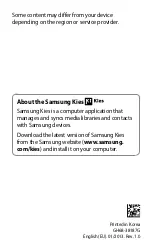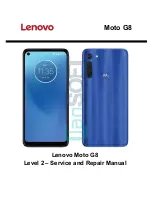
Im
por
ta
n
t Sa
fe
ty
In
for
m
a
ti
on
4A. Important Safety Information
133
Disposal of Lithium Ion (Li-Ion) Batteries
䢇
Promptly dispose of used batteries in accordance
with local regulations.
䢇
Never dispose of the battery by incineration.
䢇
Do not handle a damaged or leaking Li-Ion battery as you
can be burned.
䢇
For safe disposal options of your Li-Ion batteries, contact
your nearest Sprint authorized service center.
Special Note:
Be sure to dispose of your battery properly. In
some areas, the disposal of batteries in household or business
trash may be prohibited.
Radio Frequency (RF) Energy
Understanding How Your Phone Operates
Your phone is basically a radio transmitter and receiver. When
it’s turned on, it receives and transmits radio frequency (RF)
signals. When you use your phone, the system handling your
call controls the power level. This power can range from 0.006
watt to 0.2 watt in digital mode.
Knowing Radio Frequency Safety
The design of your phone complies with updated NCRP
standards described below.
In 1991–92, the Institute of Electrical and Electronics Engineers
(IEEE) and the American National Standards Institute (ANSI)
joined in updating ANSI’s 1982 standard for safety levels with
respect to human exposure to RF signals. More than 120
scientists, engineers and physicians from universities,
government health agencies and industries developed this
updated standard after reviewing the available body of
research. In 1993, the Federal Communications Commission
(FCC) adopted this updated standard in a regulation. In August
1996, the FCC adopted hybrid standard consisting of the
existing ANSI/IEEE standard and the guidelines published by
the National Council of Radiation Protection and
Measurements (NCRP).
Body-Worn Operation
To maintain compliance with FCC RF exposure guidelines, if
you wear a handset on your body, use the Sprint-supplied or
Sprint-approved carrying case, holster or other body-worn
accessory. If you do not use a body-worn accessory, ensure
the antenna is at least 0.866 inches (2.2 centimeters) from your
body when transmitting. Use of non-Sprint-approved
accessories may violate FCC RF exposure guidelines. Other
accessories used with this device for body-worn operations
must not contain any metallic components and must provide at
least 0.866 inches (2.2 centimeters) separation distance
including the antenna and the user’s body.
For more information about RF exposure, visit the FCC website
at
www.fcc.gov
.
Summary of Contents for Sprint SCP-3810
Page 6: ......
Page 12: ......
Page 13: ...Section 1 Getting Started ...
Page 19: ...Section 2 Your Phone ...
Page 109: ...Section 3 Sprint Service ...
Page 139: ...Section 4 Safety and Warranty Information ...
Page 156: ......
Page 157: ......
Page 158: ......
Page 159: ......
Page 160: ......
















































